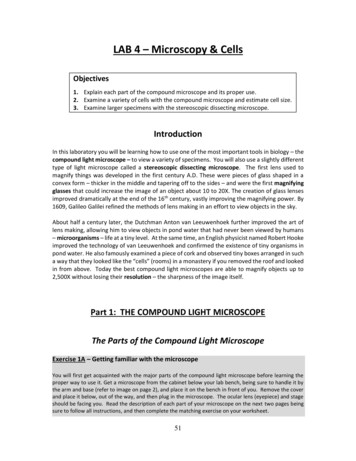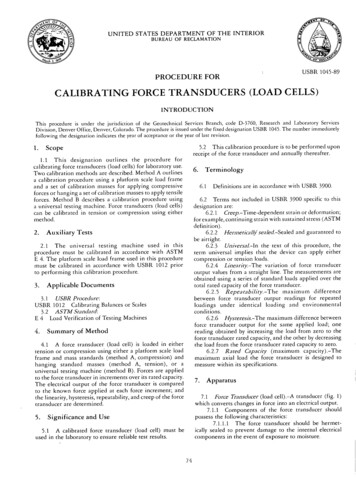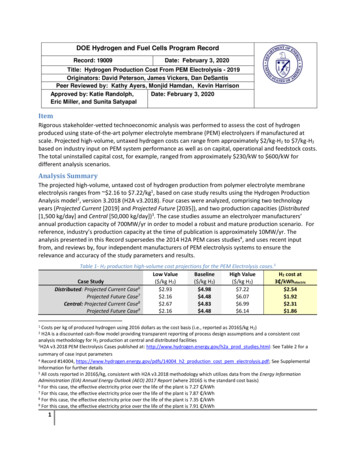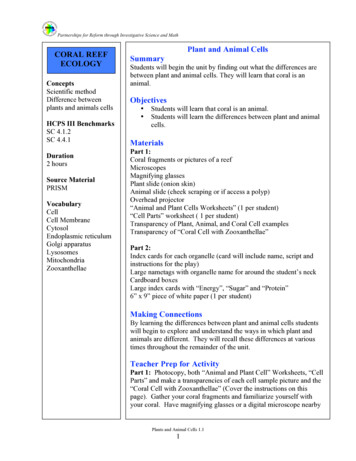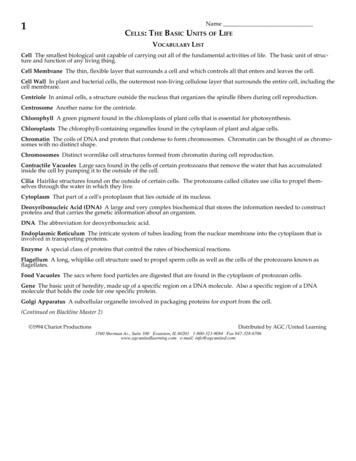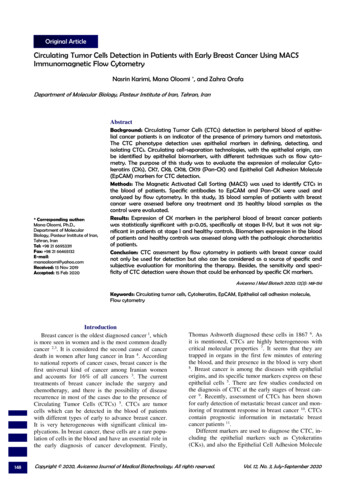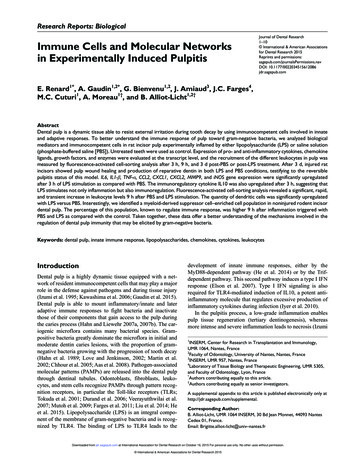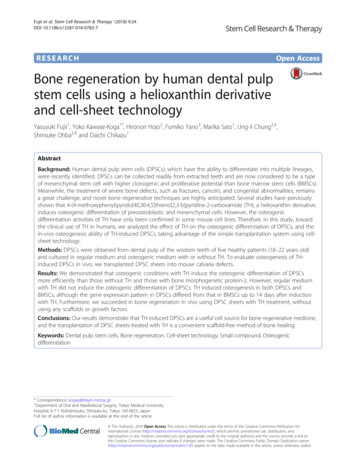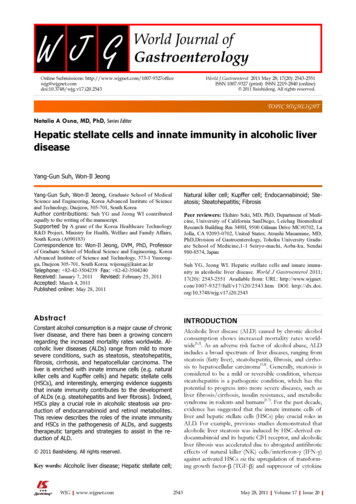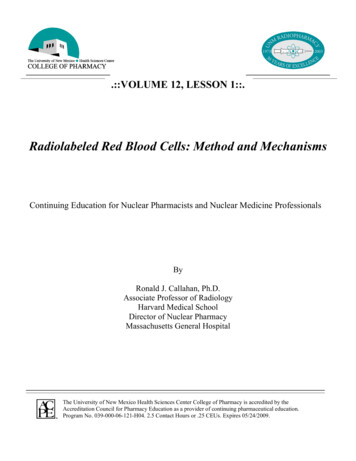
Transcription
.::VOLUME 12, LESSON 1::.Radiolabeled Red Blood Cells: Method and MechanismsContinuing Education for Nuclear Pharmacists and Nuclear Medicine ProfessionalsByRonald J. Callahan, Ph.D.Associate Professor of RadiologyHarvard Medical SchoolDirector of Nuclear PharmacyMassachusetts General HospitalThe University of New Mexico Health Sciences Center College of Pharmacy is accredited by theAccreditation Council for Pharmacy Education as a provider of continuing pharmaceutical education.Program No. 039-000-06-121-H04. 2.5 Contact Hours or .25 CEUs. Expires 05/24/2009.
- Page 2 of 24 -
Radiolabeled Red Blood Cells: Method and MechanismsByRonald J. Callahan, Ph.D.Editor, CENPJeffrey Norenberg, MS, PharmD, BCNP, FASHP, FAPhAUNM College of PharmacyEditorial BoardSam Augustine, R.P, PharmD, FAPhAStephen Dragotakes, RPh, BCNP, FAPhARichard Kowalsky, PharmD, BCNP, FAPhANeil Petry, RPh, MS, BCNP, FAPhAJames Ponto, MS, RPh, BCNP, FAPhATim Quinton, PharmD, BCNP, FAPhAS. Duann Vanderslice, RPh, BCNP, FAPhAAdvisory BoardDave Abbott, RPh, BCNPFred Gattas, PharmD, BCNPMark Gurgone, BS, RPh.Vivian Loveless, PharmD, BCNP, FAPhALisa Marmon, RPh, BCNPMichael Mosley, RPh, BCNPJanet Robertson, BS, RPh, BCNPBrantley Strickland, BCNPJohn Yuen, PharmD, BCNPDirector, CENPKristina Wittstrom, RPh, BCNPUNM College of PharmacyAdministrator, CE & Web PublisherChristina Muñoz, B.S.UNM College of PharmacyWhile the advice and information in this publication are believed to be true and accurate at the time of press, the author(s), editors, or thepublisher cannot accept any legal responsibility for any errors or omissions that may be made. The publisher makes no warranty,expressed or implied, with respect to the material contained herein.Copyright 2006University of New Mexico Health Sciences CenterPharmacy Continuing EducationAlbuquerque, New Mexico- Page 3 of 24 -
RADIOLABELED RED BLOOD CELLS:METHOD AND MECHANISMSSTATEMENT OF OBJECTIVESUpon completion of this course you will be able to discuss the methods and mechanisms by whichhuman red blood cells are radiolabeled with Tc-99m.Specifically, the recipient should be able to:1. List currently available methods by which human red blood cells are labeled with Tc-99m forclinical use.2. Define the three general steps involved in any method of radiolabeling red blood cells with Tc99m.3. Compare and contrast how each of these general steps is accomplished using currently availablemethod.4. State the relative advantages and disadvantages of currently available methods.5. Describe the role of each component found in products used to radiolabel human red blood cellswith Tc-99m.6. Describe the pharmacokinetics of radiolabeled red blood cells.7. Present the currently accepted mechanisms involved in the labeling process.8. List several drug-drug interactions that interfere in the labeling process.9. Discuss operator and patient safety issues associated with radiolabeled autologous blood products.- Page 4 of 24 -
COURSE OUTLINEI. INTRODUCTION .6II. CLINICAL INDICATIONS.6III. REVIEW OF LABELING METHODS .7IV. Tc-99m LABELED RED BLOOD CELLS (RBCs) .8V. GENERAL STEPS IN LABELING RBCs WITH Tc-99m .9A.B.C.D.Treatment of Red Blood Cells with Stannous Ion .9Removal of Extracellular Stannous Ions .9Removal of Extracellular Stannous Ions .10Addition of Tc-99m Pertechnetate.10VI. CURRENT Tc-99m RBC LABELING METHODS.10A. In Vitro Kits.10B. In Vivo Methods .11C. Modified in Vivo Methods .12VII. PHARMACOKINETICS OF Tc-99m RBCs .13VIII. COMPARISON OF RADIOPHARMACEUTICAL FOR BLOOD POOL IMAGING.13IX. DRUG INTERFERENCE .14X. RADIATION DOSIMETRY.15XI. MECHANISMS OF LABELING.16XII. FACTORS AFFECTING LABELING EFFICIENCY .16XIII. FACTORS AFFECTING LABELING EFFICIENCY .17A.B.C.D.E.Temperature.17Hematocrit .17Volume of Whole Blood.17Stannous Ion Dose .17Stannous Ion Dose .18XIV. SAFETY CONSIDERATIONS.18XV. SUMMARY AND CONCLUSIONS .18XVI. BIBLIOGRAPHY.19XVII. QUESTIONS .21- Page 5 of 24 -
RADIOLABELED RED BLOOD CELLS:METHODS AND MECHANISMSByRonald J. Callahan, Ph.D.Associate Professor of RadiologyHarvard Medical SchoolDirector of Nuclear PharmacyMassachusetts General HospitalINTRODUCTIONRadiolabeled red blood cells have played an important role as diagnostic radiopharmaceuticals formany decades. Their current role as the drug of choice for cardiac blood pool imaging has resulted inan evolution in the methods of labeling and a better understanding of labeling mechanisms. In thisarticle the use of radiolabeled red blood cells as a diagnostic radiopharmaceutical will be reviewed,current labeling methods will be presented and the understanding of the mechanisms by which thesecells are labeled will be discussed. Emphasis will be placed on technetium-99m red blood cells due totheir importance in contemporary nuclear medicine practice.Since the first version of this lesson was published in 1992 drug product selection for blood poolimaging has remained essentially unchanged. Autologous blood products remain in our formularieseven with the risks and technical difficulties associated with the handling and use of these products.While novel macromolecules like radiolabeled synthetic graft co-polymers and derivatized humanserum albumin products have been reported in recent years, including limited use in humans, acommercially available blood pool imaging product has not emerged. It is likely that highdevelopment costs and limited market potential for this class of drugs has prevented this fromoccurring.While our understanding of basic methods and mechanisms remains essentially unchanged, widespreaduse of Tc-99m red blood cells has resulted in increased awareness of potential pitfalls andidentification of interfering factors that can adversely affect the in vivo behavior, and thus, clinicalutility of Tc-99m red blood cell products. This lesson will update our current understanding of thesetopics.CLINICAL INDICATIONSThe use of radiolabeled red blood cells includes five major areas:1. Measurement of total red blood cell volume2. Measurement of red blood cell survival time3. Identification of sites of red blood cell destruction4. Blood pool imaging studies including gated cardiac imaging and gastrointestinal bleeding5. Selective spleen imaging with damaged red blood cellsThe ideal properties of labeled red blood cells used for each of these indications are different. Thephysical properties of the radionuclide, in vivo stability, and ease of labeling all have differentimportance depending on the study to be performed. For example, determination of red blood cell- Page 6 of 24 Outline
survival time requires a radionuclide with a relatively long physical half-life and good in vivo stabilitywhereas cardiac blood pool imaging studies are usually complete within 1 hour and require a shorthalf-life radionuclide. However, since these studies may be a high volume study in many nuclearmedicine departments, the speed and ease of labeling becomes an important consideration.REVIEW OF LABELING METHODSThe use of radioactive nuclides in the labeling of erythrocytes dates back to the work of Nobellaureate, George de Hevesy, when he introduced in 1942 the use of P-32 labeled erythrocytes for thedetermination of blood volume in patients. In this method, in vitro incubation of P-32 with red bloodcells allows the erythrocyte hexoses and trioses to bind the P-32.Sterling and Gray who observed that hexavalent Cr-51 in the form of sodium chromate provides asuitable label for red blood cells described an improved labeling technique in 1950. Cr-51 wasincubated in a manner similar to that of P-32. The Cr-51 method replaced the P-32 technique and isstill a commonly used labeling method. However, the relatively low abundance (9%) of the 320 keVgamma ray of Cr-51 makes it unsuited for external imaging procedures. Nonetheless, Cr-51 labeledred blood cells continue to be used, albeit with decreasing frequency, for certain lab tests involvingcounting of blood samples, namely measurement of total red cell volume and measurement of redblood cell survival time.Radioisotopes of iron have been used extensively to study red blood cells. When radioactive iron isinjected intravenously, it is cleared rapidly from the circulation (half-time 60 to 120 min) and about80% of it is incorporated into the newly formed cells over the next 7 to 10 days. Unfortunately, theiron liberated from destroyed red cells is reutilized and rapidly reappears in newly formed cells.Radioactive iron, therefore, cannot be used clinically for autologous red cell survival studies, except inspecial circumstances, e.g., aplastic anemia when reutilization would be minimal. The principalisotopes of iron used in these studies are Fe-55 and Fe-59. Neither of these iron isotopes is currentlymarketed as radiopharmaceuticals in the US.Several other methods for labeling erythrocytes have been reported over the years. Because glycine isincorporated into protoporphyrin during heme synthesis, C-14 labeled glycine has been used as a labelfor red blood cells. C-14 glycine is not marketed as a radiopharmaceutical in the US.When Hg-197 or Hg-203 labeled bromomercuryhydroxypropane (BMHP) is incubated at roomtemperature with whole blood, 90-98% of the label is rapidly bound to red blood cells. When asufficient concentration of non-radioactive mercuryhydroxypropane (MHP) is added to the cells, theyare altered in such a manner that they are selectively removed from the circulation by the spleen. Thisdamage can also be induced by heat and other chemical methods. Labeled red blood cells damaged inthis fashion are useful for selective spleen scanning. Although radio-mercury radiopharmaceuticals areno longer marketed in the US, Tc-99m labeled red blood cells (see below) damaged by heat arecurrently used, albeit infrequently, for selective spleen imaging.In 1968, Rb-81 was described as a suitable red blood cell label. The main advantage of the Rb-81 is itsshort physical half-life (4.7 hrs.) and suitable gamma-ray energy. It has also been reported useful forquantitative estimation of red cell uptake in the spleen.Rb-81 is not marketed as aradiopharmaceutical in the US.- Page 7 of 24 Outline
A method for the measurement of red cell mass in the spleen by radionuclide scanning after theinjection of C-11 labeled carbon monoxide has been described. Because of its short physical half-life(20 min), large amounts of the radionuclide can be administered and the spleen visualized withoutdamage to red blood cells. However, the major disadvantage of this method is the necessity of havinga cyclotron nearby for the production of this short half-life position-emitting radionuclide. The recentincrease in the number of positron emission tomography (PET) facilities may increase the interest inthis novel technique.The introduction of lipid-soluble complexes of In-111 led to the use of this radionuclide to labelplatelets and white blood cells. The physical half-life of 2.8 days and suitable gamma emissions of174 and 247 keV make it ideal for monitoring physiologic processes which are several days induration. In-111 labeled red blood cells have been proposed for detection of gastrointestinal bleedingand red blood cell sequestration and survival studies. In-111 oxine is a suitable product for labelingred blood cells as an off-label use.Lipid-soluble complexes of Ga-67 and Ga-68 have also been reported as alternatives to more commonmethods for special applications such as the use of Ga-68 red blood cells in PET. Such radiogalliumproducts are not marketed as radiopharmaceuticals in the US.Tc-99m LABELED RED BLOOD CELLS (RBCs)Many of the radionuclides previously mentioned above lack physical properties that allow for their usein imaging procedures. These limitations restricted the use of red blood cells labeled with thesenuclides to in vitro determinations or external probe counting techniques. The availability of aradiotracer with physical properties suited to imaging techniques and with chemical properties whichwould permit efficient labeling to red blood cells has greatly expanded the usefulness of labeled redblood cells as a diagnostic agent. The introduction of Tc-99m has singularly had the greatest impacton radionuclide procedures, including those with labeled red blood cells.The use of Tc-99m labeled red blood cells as a blood pool imaging agent in nuclear cardiology is wellestablished. Clinical effectiveness of this agent is based on its ability to distribute primarily within theintravascular pool of the body and to leave this compartment at a slow rate. Such behavior allows forthe accumulation of high resolution images which can be obtained with the aid of a physiologicalgating device. Combined with the gamma scintillation camera, this procedure can yield diagnosticinformation about dynamic processes such as regional myocardial wall motion and left ventricularejection fraction.Tc-99m as the pertechnetate ion is not firmly bound to red blood cells and will diffuse into theextravascular fluid compartment, with accumulation in organs such as the stomach, gut and thyroidgland. Such a distribution pattern results in lower blood-to-background activity ratios, poor detectionof myocardial borders, interference with GI blood pool imaging and images which are difficult orimpossible to interpret. It is, therefore, important that the Tc-99m be firmly and quantitatively bound tothe cells and that this labeling persist in vivo during the observation period. In nuclear cardiology thistime period may be 1 hour, while in the evaluation of gastrointestinal bleeding, the observation periodmay be as long as 24 hours.Labeling of red blood cells with Tc-99m for spleen scanning was reported in 1967. However, effortsat that time to reproduce Tc-99m labeling of red blood cells had been unsuccessful. In these studies,Tc-99m was added as pertechnetate ion without the addition of any reducing agent. It is now well- Page 8 of 24 Outline
known that pertechnetate ion (with Tc-99m in the 7 oxidation state) is nonreactive, and binding tocellular components would not be expected under the reaction conditions employed by these authors.In 1971, a labeling method employing stannous chloride as a reducing agent for technetium wasintroduced with labeling efficiencies of 50 to 60% reported. The method involved the incubation ofwashed cells with pertechnetate followed by the addition of stannous chloride solution. It wasobserved that the presence of plasma greatly reduced the labeling efficiency by this method but that thelabeled cells exhibited good in vivo and in vitro stability. All of the early methods involvederythrocyte separation from anticoagulated whole blood by centrifugation with subsequent incubationwith stannous chloride followed by pertechnetate, or with pertechnetate followed by stannous chloride.GENERAL STEPS IN LABELING RBCs WITH Tc-99mBefore presenting details of current labeling methods, it is worthwhile discussing the general stepsinvolved in labeling red blood cells with technetium since they are common to all methods. There arethree general steps involved:1. Treatment of RBCs with stannous ion2. Removal of excess extracellular stannous ion3. Addition of pertechnetateTreatment of Red Blood Cells with Stannous IonAlthough it is technetium in the 7 (pertechnetate) oxidation state that crosses the intact erythrocytemembrane, only technetium that has been reduced to a lower oxidation state will firmly bind tohemoglobin. Stannous ions are most commonly employed for reduction of technetium and stannouschloride (as a stannous pyrophosphate complex) is preferred. At physiologic pH, stannous ions aresubject to hydrolysis and precipitation that causes their rapid clearance from blood by thereticuloendothelial system. When complexed with pyrophosphate (or other soluble chelates), however,stannous ions are sufficiently soluble to be resistant to these effects, yet are not so strongly bound topyrophosphate as to prevent their dissociation and passage into red blood cells. In the in vivo andmodified in vivo methods, treatment with stannous ion is accomplished by the direct intravenousadministration of stannous pyrophosphate. Other chelates of stannous ions can also be used (such aspentetate, medronate, etc.) and would yield radiolabeled red blood cells with varying degrees ofefficiencies. Pyrophosophate seems nearly ideal, however, because (a) it maintains the solubility ofstannous ions in serum until they come into contact with the red blood cells and (b) most kits containan optimal amount of stannous ion.Reports on the quantity of stannous ion required for RBC labeling have been confusing because thequantity of tin to be given is stated in terms of stannous ions, stannous chloride, or stannouspyrophosphate. For Tc-99m red blood labeling using the in-vivo or the modified in vivo technique,most clinicians utilize 10-20 micrograms Sn 2/kg body weight. Depending upon the commercialformulation chosen, it may be necessary to inject one-third, one-half, or the entire contents of a vial ofstannous pyrophosphate to provide required mass of stannous ions. When the in vitro method ofradiolabeling is employed, a
Director of Nuclear Pharmacy Massachusetts General Hospital The University of New Mexico Health Sciences Center College of Pharmacy is accredited by the Accreditation Council for Pharmacy Education as a provider of continuing pharmaceutical education. Program No. 039-000-06-12



